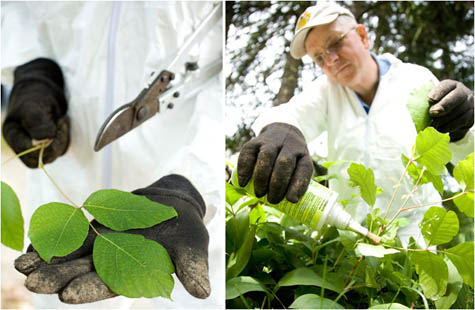Chemical Nature
 [Images: Poison ivy, resplendent in high-CO2 environments. Photos by Steve Legato for The New York Times].
[Images: Poison ivy, resplendent in high-CO2 environments. Photos by Steve Legato for The New York Times].One of the oft-repeated myths of the present day is that climate change cannot possibly be bad for the living environment; plants will simply thrive in the increased levels of atmospheric CO2. After all, some people call it pollution while others call it life, right?
Well, it turns out that at least one plant unfortunately does like all that carbon dioxide: poison ivy is not only thriving, it is growing more virulent.
The New York Times today reports that "Researchers at Duke University who studied the weed between 1999 and 2004 in a controlled forest area near Chapel Hill, N.C., where high levels of CO2 are pumped into test plots, found that poison ivy not only grew more vigorously, but also produced a more toxic form of urushiol, the resin that causes its rash."
First, let me briefly say that I've actually been to that forest. I once lived, and went to college, in the area, and I had friends who'd developed fascinating conspiracy theories about all those strange devices pumping something – some kind of invisible gas – into the forest... It was all very X-Files.
Second, the article goes on to interview a local horticulturist who now makes a living killing poison ivy. However, he quietly expresses hope that Americans will someday "discover some use for the plant," referring to poison ivy as a kind of overlooked decorative resource. "In China and Japan," he says, "they made lacquer out of their resin plants, so they understand and value it... Whereas we just see it as that darn weed over there."
Of course, it's interesting to project a direct relationship here between the amount of lacquered furniture being produced in the United States and the intensity of global climate change – that as the latter goes up, so does the former – but such speculation would miss a more interesting point, which is that climate change will not only alter the atmospheric composition of the planet, it will alter the chemical nature of the life that's able to thrive on it.





Comments are moderated.
If it's not spam, it will appear here shortly!
While I'm sure there's _something_ good that can come out of urushiol resin, I'm not sure I like the idea of lacquered furniture goods being made out of it.
Too many people think that the rash is contagious long after the resin is washed off the skin to make the furniture thing a good business plan.
Though I bet there's some medical use for it.
This other article from the NYT magazine is even more interesting in this regard...
http://www.nytimes.com/2008/06/29/magazine/29weeds-t.html
Hey,
Not quite sure how to get in touch with you on this site, but would you consider a link exchange with www.gunpowder-magazine.com?
Thanks!
Nick
Why couldn't global warming be causing a boom in wild strawberries, or at least blackberries? I'd be willing to put up with more thorny vines if it meant that the berries were getting more numerous, large and tasty.
But no, it's just got to be poison ivy. No climate change escapism for us.
Guess furniture companies should already start figuring out how to brand poison ivy lacquer as "100% natural, local, organic finish". Or maybe someone could create a line of Ivy League bookshelves?
As someone who breaks out in a rash yearly because of Poison Ivy - even if I'm nowhere near it - I'm more of the "that darn weed over there" varity of person. ;)
"Why couldn't global warming be causing a boom in wild strawberries, or at least blackberries?"
There are a lot of wild blackberries where I live - but you can't get to them because they're overgrown with poison ivy! A couple of years ago I could walk down the sidewalk past a small open area and pick berries, but now I can hardly even walk down the sidewalk because the poison ivy has overgrown and is hanging off the trees and over the guardrail.
@ writer: you truly have my sympathies. I've only had the stuff once, but I don't think I've ever been more miserable in my life! In the mean time, my dad and grandpa seemed to be able to pull the stuff out by the roots and burn it and be totally unaffected.
we have the same problem in forests around the Balcan Pennisula!
Let's not forget that poison ivy is a border plant living in the zone between forest and open space. As we cut more into the forest we are creating more of it's zone to live in. Recently I worked at a new office building built in a "natural preserve" one only has to look at the new landscape that is cut from deep forest to see all the new area where poison ivy will live. Maybe we should have a different criterial to the way we landscape around buildings?
Maybe someone should try to make biofuel out of it, thus closing the circle.
Post a Comment